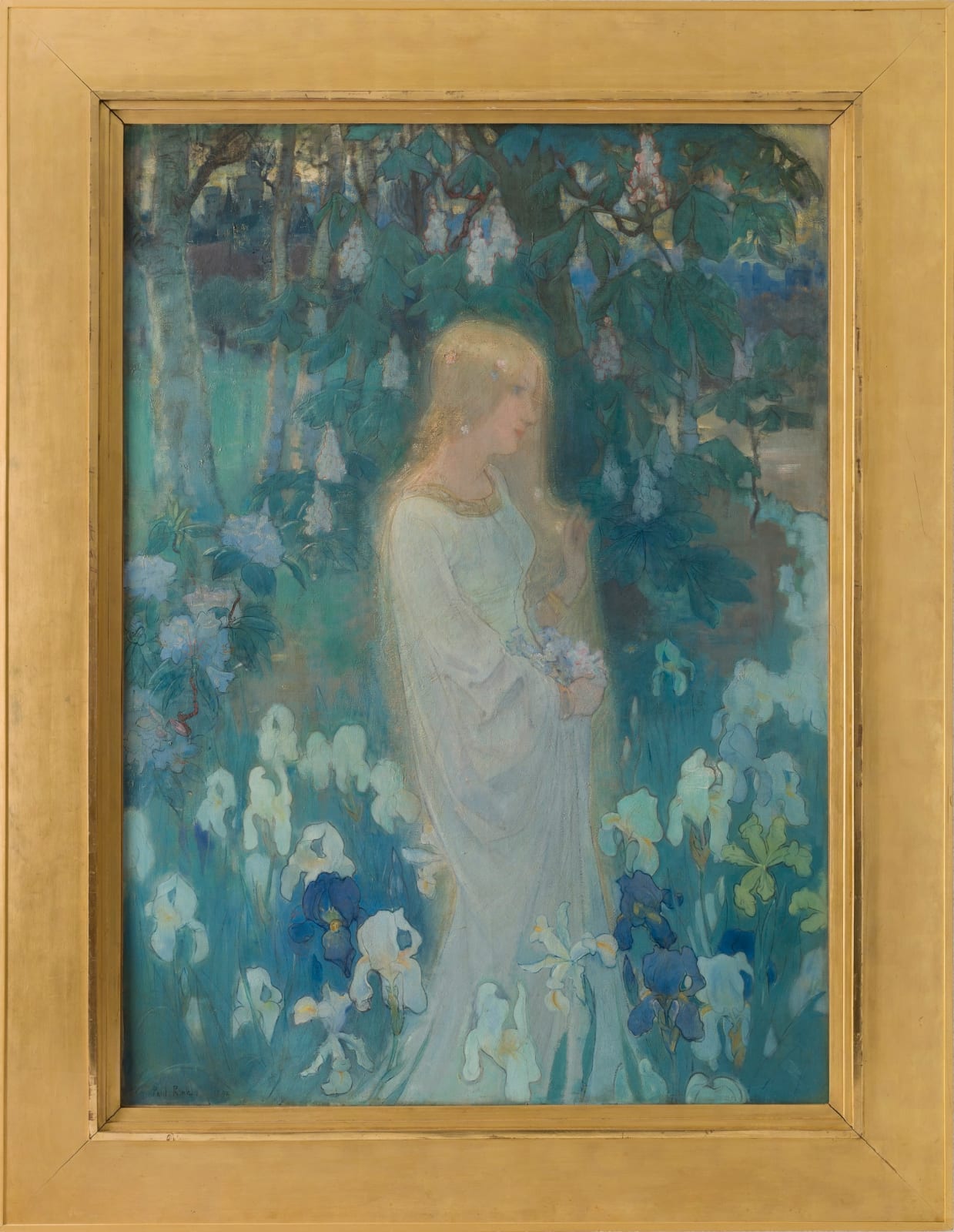Paul Rink (1861-1903)
Signed & titled verso
Rink’s monumental symbolist interpretation of Iris received critical acclaim when it debuted in 1893. The painting was immediately acquired by Mrs. Van Biema, a bold female patron at a time when women’s roles in the art world were still emerging. However, the Jewish Van Biema family’s story would take a tragic turn during World War II, facing deportation and dispossession. After the painting’s then-owner, Eduard van Biema, died on December 16, 1942, his housekeeper and sole heir, the Catholic Czech-born Maria Saxel entrusted Iris to her fellow resistance fighter Frans Duwaer for safekeeping.
Duwaer, encouraged by his friend Willem Sandberg, director of the Stedelijk Museum, turned his Amsterdam printshop into a clandestine hub of resistance, producing some 70,000 false identity cards. On June 8, 1944, Duwaer was arrested and was executed two days later. Saxel, too, was arrested earlier that year, on April 21, 1944, for her involvement in falsifying documents. Saxel survived Dutch prisoner’s camp Vught, Ravensbrück, a Nazi concentration camp exclusively for women, and a grueling march to the Agfa-Commando satellite camp at Dachau.
After the war, Saxel undertook the arduous process of reclaiming Iris, deposited by Duwaer for safekeeping at the Stedelijk Museum in March 1943. It was a burdensome task for Saxel to claim ownership: while Duwaer had not survived the war, ownership records were purposely absent in the museum. Finally, on April 10, 1946, Saxel was reunited with Iris.
The intertwined stories of Iris and its courageous custodian embody resilience and hope. As Iris, Olympian messenger, bridged the heavens and the earth, Saxel, serving as a courier for the resistance, carried coded communications through clandestine routes to sustain the fight against oppression. Just as the rainbow signifies hope after the storm, Saxel’s unwavering courage illuminated a path through humanity’s darkest hours. For her, Iris likely remained a potent symbol of solace and survival. Today, Rink’s Iris stands not only as a masterpiece of Dutch symbolism but also as a lasting testament to the indomitable spirit of those who resist tyranny.
Provenance
Pulchri Studio, The Hague, 1893, sold for ƒ400 to
Mrs. Van Biema, The Netherlands, by descent
Eduard van Biema (1858-1942), Amsterdam, by inheritance
Maria Saxel (1908-1995), Amsterdam, given to
Frans Duwaer (1911-1944), Amsterdam, by whom given in protective custody to
Gemeente musea, Amsterdam, March 1943, according to label verso, returned to
Maria Saxel, 10 April 1945, The Hague
Collection Van Genderen, The Netherlands
Christie’s, Amsterdam, 25 April 1996, lot 46, sold for ƒ41,400
Private collection, The Netherlands
AAG, Amsterdam, 16 November 2020, lot 170
Private collection, The Netherlands
Exhibitions
The Hague, Pulchri Studio, Winter 1892-1893
Arnhem, Musis Sacrum, Tweede Internationale Tentoonstelling van Kunstwerken van Levende Meesters, 8 Augustus-9 September 1893, no. 336, list price ƒ500
The Hague, Pulchri Studio, Tentoonstelling van werken van wijlen Paul Rink, 3-19 March 1904, no. 53 (lent by Mrs. Van Biema)
‘s-Hertogenbosch, Noordbrabants Museum, Bloeiende symbolen. Bloemen in de kunst van het fin de siècle, 6 February-9 May 1999
Chichester, Pallant House Gallery, Innocence and Decadence: Flowers in Northern European Art 1880-1914, 4 June – 5 September 1999
Paris, Institut Néerlandais, Symboles en fleurs: les fleurs dans l'art autour de 1900, 30 September-28 November 1999
Literature
“In Pulrchi I”, Arnhemsche Courant, 9 March 1893
“In Pulrchi III”, Arnhemsche Courant, 18 March 1893
“Kunst en Wetenschap”, Arnhemsche Courant, 13 September 1893
Haagse Courant, 14 September 1893
P.A. Haaxman jr., “Rink in Pulchri”, Elsevier Tijdschrift, XIV, no. 5, May 1904, pp. 295-305, p 295
“Kunstberichten van onze eigen correspondenten uit Den Haag – Pulchri Studio – Tentoonstelling Paul Rink”, Uit Onze Kunst, III, 1904, pp. 159-160
Willemijn van de Walle-van Hulsen, unpublished doctoral thesis
Willemijn van de Walle-van Hulsen, Paul Rink: Veghel 1861-1903 Edam: een bevlogen Brabantse Tachtiger, ‘s-Hertogenbosch, Noordbrabants Museum, 1999
Marty Bax a.o., Bloeiende symbolen. Bloemen in de kunst van het fin de siècle, ’s-Hertogenbosch exh.cat. 1999, no. 69, p. 92 & 122
Marty Bax, a.o., Innocence and Decadence: Flowers in Northern European Art 1880-1914, exh.cat. Chishester 1999, no. 69, p. 98
Marty Bax a.o., Symboles en fleurs: les fleurs dans l'art autour de 1900, exh.cat. Paris 1999,
cat.no. 61, p. 69J.A. Schröeder, Paul Rink 1861-1903, Amsterdam 2000, unpublished thesis, p. 85, appendixes E5, F3, F5, G1



